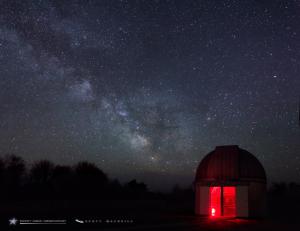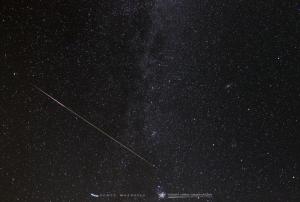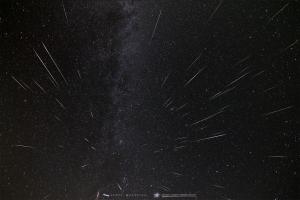
Stargazing Night
- Where:
- Frosty Drew Observatory
- When:
- Friday November 13, 2015 at 6:30 p.m.
- Cost:
- $1 Suggested Donation per Person
Tonight is Stargazing Night at Frosty Drew Observatory and we could be in for a great night of sky watching. Forecasts are calling for mostly clear skies with short periods of passing clouds. Add in that the 4% waxing crescent Moon will set at 6:08 p.m. and we have a night of super dark, relatively clear skies. So now the Friday the 13th part of tonight's forecast, wind. We can expect 18-23mph sustained winds, gusting to 38mph. That is way over our acceptable limits! Wind will kick up dust and dirt around the observatory causing it to interfere with and dirty our optics as well as create excessive stress on the telescope's gears and tracking mechanisms. We will make a best effort attempt to view the sky, though we'll likely be restricted to the eastern side of the sky, at best. Wind will not interfere with our ability to catch views of shooting stars compliments of the Taurid and Leonid meteor showers, which are currently putting on a nice display.
We will open the Observatory and Sky Theatre at 6:30 p.m. tonight. In the Observatory, we will be fighting the wind with telescope viewing restricted to the eastern sky. We will closely monitor wind conditions inside the observatory and take the night as it goes. If we catch a view, binary stars, star clusters, and galaxies will be on display. In the Sky Theatre we will show our popular astrophoto presentation that features celestial objects photographed at Frosty Drew Observatory. We will stay open until the weather kicks us out.
Overall, tonight's skies will be fabulous to view without a telescope. The waning Taurid meteor shower and incoming Leonid meteor shower are producing a good display of shooting stars with about 15-30 meteors visible over the night. Watching the sky and meteors will not be wind dependent. Telescope views may be difficult, though we could score in the eastern sky, which is the direction to catch all the new objects of the season. Temperatures will be cool and demanding moderate winter time garb. So grab your coat, hat, friends and family and head out to the darkest spot in Rhode Island and catch a meteor streaking by or just a moment with the stars.
-------------------------------------------------------------------------
Weekly Happenings
Scott MacNeill
This coming Tuesday night, November 17th and overnight into the 18th, the annual Leonid Meteor Shower will peak. Producing upwards of 15 meteors per hour, the Leonid shower will put on a meager, yet notable display of shooting stars and often confuses casual sky watchers that expect a much more active meteor display.
Resulting from Earth passing through a debris field left behind by comet 55P Tempel-Tuttle, the Leonid Meteor Shower has an erroneous reputation of producing the best display of the year. This reputation comes from a solid history of producing meteor storms, which happen on a 30 year interval when Earth passes through very dense streams along the comet's debris field. The Leonid storms of 1833, 1866, 1966, and 2001 were legendary, producing upwards of 3,600 meteors per hour! Outside of the 30 year cycle, the Leonid shower is rather dull comparatively and certainly not the best shower of the year. But everybody remembers that amazing 2001 display.
The Leonids are still a shower to get out and watch. Producing a modest 15 meteors per hour, watchers can expect the occasional bright meteor that leaves behind a persistent train, which are visible trails left in the sky after the meteor passes that slowly dissipate. Since the 33% waxing crescent Moon will set before 10:00 p.m. on the 17th, we are in for excellent meteor watching conditions. For best viewing, set out after midnight with a reclining lawn chair and blanket. Lay down with your feet towards the East and look at the zenith (top of the sky). Relax and enjoy the starscape with meteors streaking by.
As with any meteor shower, the Leonids present a great photo op! Setup your camera on a tripod with an intervalometer, expose the sky for 30 seconds on a fast interval. Set your ISO to a relatively mid-to-high setting (this will vary based on your camera) and keep your aperture wide open or stopped down one stop to reduce distortions at the edge of your field. If you catch a meteor in your shot, post it on the Frosty Drew Observatory Facebook page and we'll share it on our time line.
Happy meteor hunting!
-Scott


